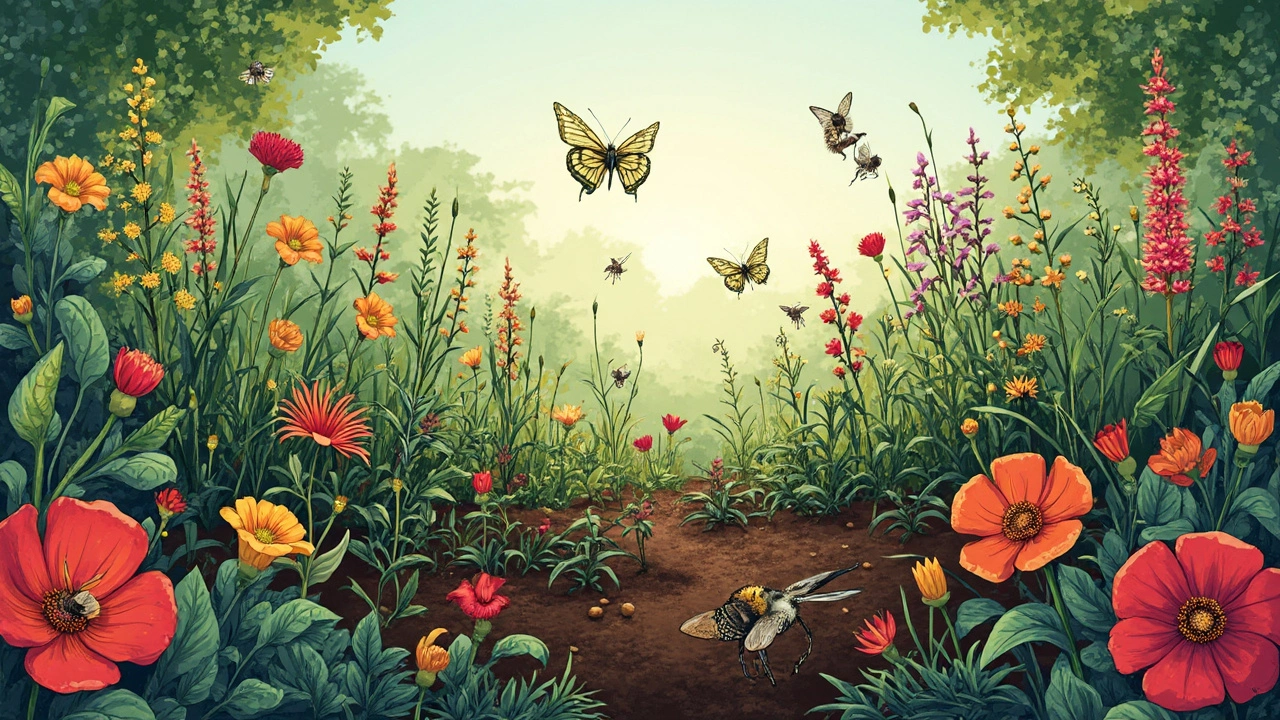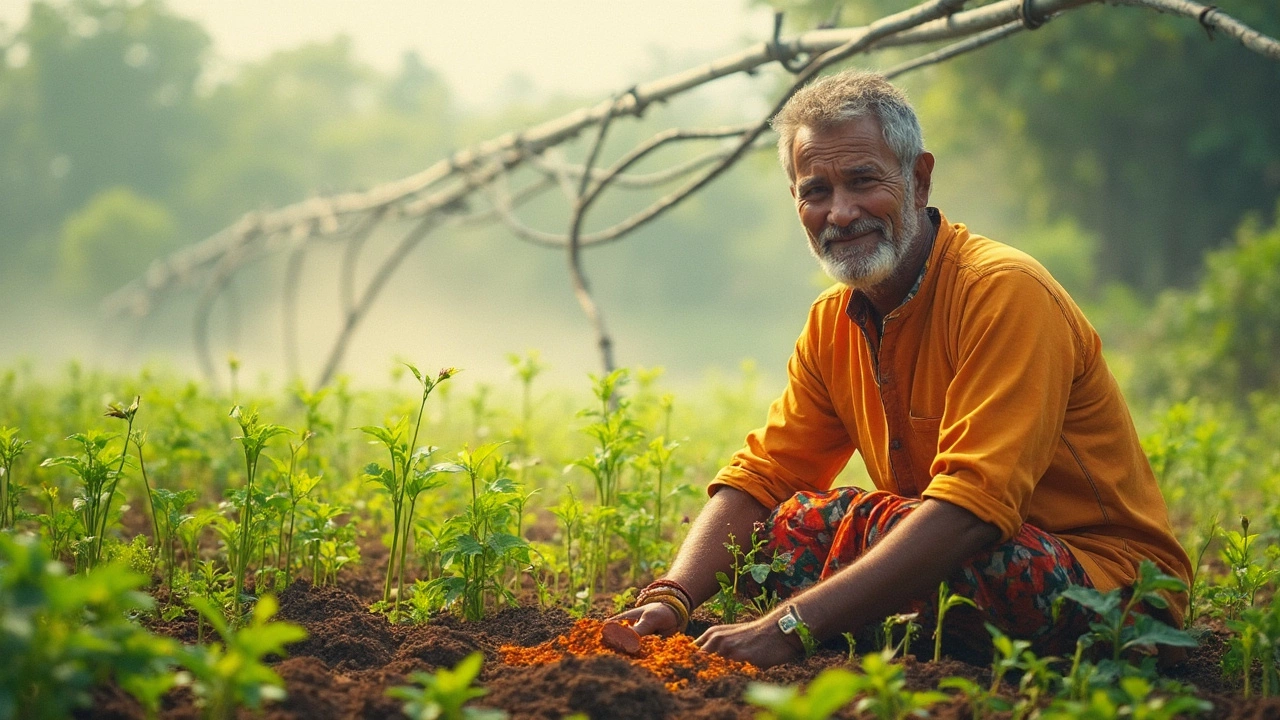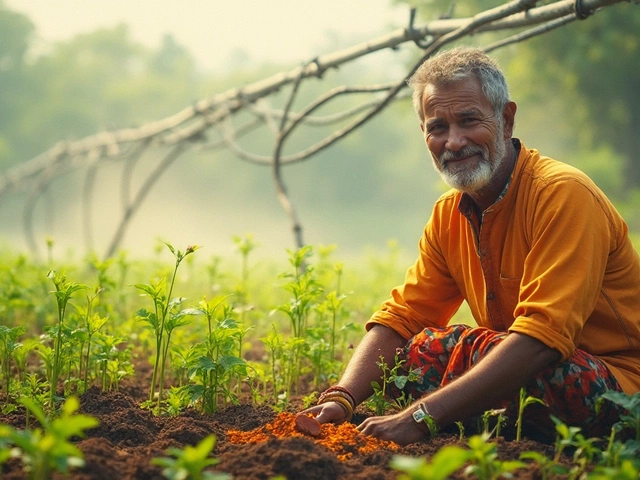Have you ever heard of regenerative agriculture? It's like the buzzword of sustainable gardening right now. This practice isn't just about growing more plants; it's about healing the land in the process. But is it really the game-changer it's hyped up to be?
Regenerative agriculture focuses on restoring and enhancing soil health, which is a big deal for anyone with a green thumb. We're talking about using techniques that boost soil's natural fertility, so you get healthier plants without relying heavily on fertilizers or chemicals. Neat, right?
One of the coolest aspects is how it promotes biodiversity. Instead of a monoculture, where you see rows and rows of the same crop, regenerative farming encourages a mix. This not only supports a range of insects and wildlife but also keeps your garden thriving against pests.
Then there's the way it deals with water. Instead of letting precious rainwater slip away, regenerative practices aim to capture and retain it. Proper water management is crucial, especially with the unpredictable weather patterns we're dealing with these days.
Still, it’s not all sunshine and rainbows. Some folks argue about the feasibility of these methods on a large scale and whether they can be cost-effective. But if you're a gardener looking to try something new, integrating a few regenerative practices could do wonders for your plot.
- What is Regenerative Agriculture?
- Benefits for Soil Health
- Impact on Biodiversity
- Water Management Practices
- Challenges of Regenerative Methods
- Practical Tips for Gardeners
What is Regenerative Agriculture?
Regenerative agriculture is a farming approach focused on improving the soil, boosting biodiversity, and building a healthier ecosystem. Unlike conventional farming, which can deplete the land, regenerative practices aim to restore it, making your garden more sustainable in the long run.
At its core, this method is all about working with nature rather than against it. Think of it as giving back to the earth while you grow your favorite veggies. It embraces techniques that enrich the soil, like composting and using cover crops. These actions help bring back vital nutrients to the ground, save water, and even pull carbon out of the air. Yes, it actually helps tackle climate change!
Key Principles
- Soil Health: The heart of regenerative agriculture is maintaining dirt that's full of life. Healthy soil means fewer pests and stronger plants.
- Crop Diversity: Mix it up when planting! Different plants support diverse insect populations, which keep pests in check and improve pollination.
- Minimal Tillage: Less digging around means the soil structure and the critters within it stay intact, helping with water retention.
- Natural Inputs: Say goodbye to chemical fertilizers. Use natural amendments to nourish the soil instead.
And here's a fun fact: some stats say regenerative practices can increase yields by up to 21% in some cases. So not only are you being environmentally friendly, but you might also see more produce in your garden.
For anyone interested in sustainable gardening, regenerative agriculture isn't just a trend— it's a whole new way to think about how we interact with the earth. It's practical, actionable, and can be applied whether you have a small backyard garden or a larger plot.
Benefits for Soil Health
If you're into regenerative agriculture, you've probably heard folks rave about how it does wonders for soil health. But what exactly does that mean? Well, in simple terms, it's all about making your soil richer and healthier, which naturally leads to stronger, more resilient plants.
Boosting Soil Fertility
So, how do you actually boost soil fertility? It starts with organic matter. Adding compost or mulch is like giving your soil a health drink loaded with nutrients. This stuff breaks down over time, nourishing the soil and improving its structure, which helps plants grow.
Increasing Microbial Life
Your soil is alive, full of tiny organisms that help decompose organic material and release nutrients. Healthy soil teems with these microbes. Through practices like cover cropping and reduced tilling, regenerative gardening supports this microscopic community, making soil more fertile and plants healthier.
Better Water Retention
Every gardener knows that too much or too little water can be a nightmare. Regenerative methods help create soil that holds onto moisture better, so you use less water and your plants are happier. No more worrying about sudden dry spells!
Reducing Erosion
We've all seen erosion strip away topsoil after a heavy rain. It's frustrating! Regenerative agriculture helps keep this precious layer intact. By maintaining plant coverage and adding organic matter, it reduces runoff, keeping your soil where it belongs—right in your garden.
Carbon Sequestration
Did you know your garden can help fight climate change? Regenerative farming methods capture and store carbon in the soil, reducing greenhouse gases in the air. Besides being eco-friendly, this also boosts the amount of carbon available for plant growth.
Overall, the soil is where it all begins. If you're looking to make your gardening efforts more sustainable, focusing on soil health through regenerative techniques is a smart move. Healthier soil means less need for chemicals and more bountiful harvests.
Impact on Biodiversity
When it comes to biodiversity, regenerative agriculture is all about maximizing variety. The idea is to embrace nature's diversity rather than sticking to traditional farming's limited crop choices. This method does wonders not just for your garden, but for the planet.
So, how does it actually work? Imagine you’re planting a mix of veggies, herbs, and flowers instead of just one type of crop. This diversity attracts all sorts of beneficial insects, like bees and ladybugs, which help with pollination and pest control. Not to mention, it creates a rich habitat for wildlife, giving birds and other critters a welcoming space to thrive.
Boosting Pollinator Populations
One of the standout performers in the regenerative agriculture approach is its positive impact on pollinator populations. By planting a variety of flowering plants, you can create a year-round feast for bees and butterflies. This is crucial because pollinators are facing threats from habitat loss and pesticides. Your diverse garden becomes a safe haven for them.
Building Resilient Ecosystems
A more biodiverse garden doesn't just look good; it's more resilient. When you have a wide range of plants, your garden can better withstand unexpected challenges, like pest invasions or sudden weather changes. Think of it as having multiple backups in place—in case one plant struggles, others can pick up the slack, keeping your garden productive.
An interesting fact to keep in mind is that research has shown biodiversity can be linked to healthier soil, which ties back to stronger plant growth and reduced need for fertilizers. It's like a win-win situation for everyone involved!
Keeping Pests in Check
By nurturing a community of different plant species, you're naturally regulating pest populations. Predators like birds and insect-eating insects make themselves at home, keeping those pesky garden invaders in check without chemical sprays. It's nature's own pest control system!
| Type of Insect | Role |
|---|---|
| Ladybugs | Consume aphids and other pests |
| Honeybees | Pollination |
| Birds | Control insect population |
Ultimately, incorporating biodiversity through regenerative methods isn't just about changing how we plant; it's about enhancing the entire ecosystem. And yeah, it's pretty exciting to see a garden buzzing with life!

Water Management Practices
When it comes to sustainable gardening, water plays a huge role. How we manage this precious resource can make or break your regenerative agriculture efforts. So what’s the secret sauce?
Rainwater Harvesting
First off, capturing rainwater is a great start. A simple rain barrel under your downspout can collect gallons of water, ready to quench your garden during dry spells. It's all about making the most of what falls naturally. It’s an easy and cost-effective way to ensure your plants get watered without hiking up your water bill.
Mulching
Ever thought about mulching? By layering organic material like straw or wood chips on top of your soil, you can lock moisture in. Plus, it helps keep weeds down—less work for you!
“Mulching serves as a form of soil armor, protecting it from moisture loss and nutrient depletion.” – Dr. Jane Andrews, Soil Conservationist
Drip Irrigation
Another bright idea is drip irrigation. Unlike traditional sprinklers, this system delivers water directly to the plant roots, minimizing waste. It's super-efficient, especially for larger garden areas.
Keyline Design
For those who have some more space, you might hear about keyline design. This method involves shaping the land to direct water where it's most needed, enhancing natural drainage patterns. It’s like giving your garden a cool topographical facelift!
Let’s look at water use in numbers:
| Water Use Method | Efficiency |
|---|---|
| Traditional Sprinklers | 30-50% |
| Drip Irrigation | 80-90% |
Whether you're capturing rain, mulching, or rethinking your irrigation, making small changes in how you manage water can transform your garden. Not only are you conserving water, but you’re also nurturing a healthy, thriving ecosystem in your own backyard.
Challenges of Regenerative Methods
Regenerative agriculture sounds great and all, but it's not without its hurdles. Let's dive into some of the real-world challenges folks face when trying to go down this eco-friendly path in gardening.
Initial Transition Concerns
First off, switching from conventional farming to regenerative agriculture isn't as simple as flipping a switch. There's a learning curve involved, especially if you're used to conventional gardening. You'll need to adapt to new practices, which can be both time-consuming and a bit intimidating at first.
Economic Viability
One of the most talked-about issues is cost. Implementing sustainable gardening practices might require an initial investment. For example, cover crops and composts instead of chemical fertilizers can strain some budgets. Hobby gardeners might find it doable, but larger farms can struggle to justify the expenses when profits aren't immediate.
Scalability Issues
Then there's the question of scale. While regenerative methods work wonders on a backyard scale, not everyone is convinced of their efficiency on large farms. Can these practices feed a hungry world? That's the million-dollar question some skeptics are asking.
Need for Continuous Monitoring
Monitoring progress is crucial. Regenerative agriculture requires constant attention and evaluation. Soil health needs regular checkups, and you might need to tweak your methods as you learn what works best in your specific conditions.
Resistance to Change
Let's not forget about the human factor. Change is hard, and not everyone is eager to adopt new ways, even if they're potentially better for the environment. It often needs leadership buy-in and community support to see real shifts happen.
Despite these challenges, sustainable gardening through regenerative methods offers unique rewards. As they say, nothing worth having comes easy!
Practical Tips for Gardeners
Ready to bring regenerative agriculture into your backyard? It's easier than you might think, and I've got some straightforward tips to get you started.
Start with the Soil
The first thing a gardener should focus on is soil health. Instead of disrupting it, aim to keep the soil as intact as possible. Think of the soil like a living community—worms, fungi, and bacteria all call it home. Avoid tilling as much as possible to protect these little helpers.
Consider adding a mix of organic compost. It's like feeding your soil a healthy smoothie, packed with nutrients that improve fertility naturally.
Cover Crops Are Your Friends
If your veggies or flowers are taking a break, keep the soil covered. Cover crops like clover or rye not only protect the soil from erosion but also add more nitrogen back into the ground.
Mix it Up
Diversity in your garden is key. Try to avoid planting the same crop repeatedly in the same spot. Rotating crops can help reduce pests and diseases. Think about planting companion plants together, like tomatoes with basil, to support each other’s growth.
- Tomatoes and Carrots
- Beans and Corn
- Garlic and Roses
Water Wisely
Paying attention to water management is crucial. Use mulch to retain moisture and save water. Drip irrigation systems are a great way to give plants the right amount of water without waste.
| Water Savings | Technique |
|---|---|
| 30% | Using Mulch |
| 70% | Drip Irrigation |
Keep an Eye on Your Garden
Be observant and learn from your plants. They show signs when they're stressed or not getting what they need. Taking notes or snapping pics can help track what works best.
Sustainable gardening might require some adjustments, but it's all about working with nature rather than against it. Once you get the hang of it, your garden will thrive, and you'll be contributing to a healthier planet—one plant at a time.




